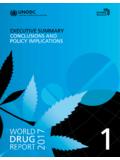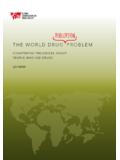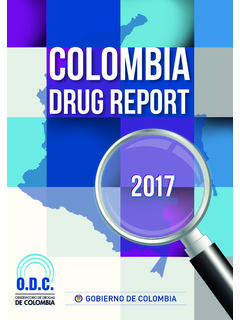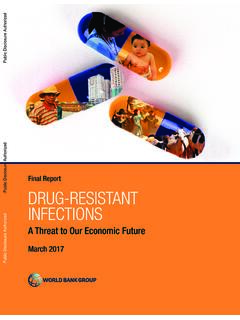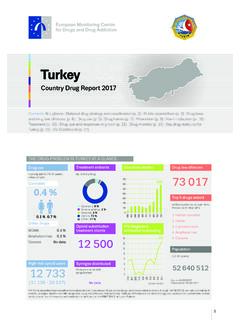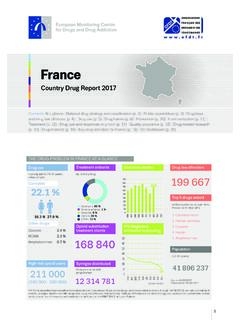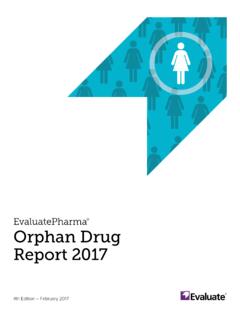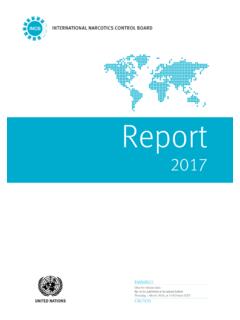Transcription of Drug REPORT- 2017
1 drug Abuse Trends in the Minneapolis/St. Paul Metropolitan Area April 2017 Carol Falkowski drug Abuse Dialogues St. Paul, Minnesota ABSTRACT The far-reaching consequences of heroin and methamphetamine abuse and addiction maintained a stronghold in the Minneapolis/St. Paul metropolitan area in 2016. From 2015 to 2016, opiate-related overdose deaths rose percent in Hennepin County (from 97 to 153), and in Ramsey County rose 32 percent (from 47 to 62). Deaths involving fentanyl contributed to these increases. A record-high percent of admissions to addiction treatment programs were for heroin in 2016.
2 Methamphetamine (meth) accounted for percent of total treatment admissions in 2016, and again surpassed admissions at the height of the statewide meth epidemic in 2005. In 2016 cocaine-related deaths increased in both Ramsey and Hennepin County. Exposures declined for synthetic cannabinoids (THC homologs), "bath salts" (substituted cathinones), "research chemicals" (2-CE analogs), and MDMA in 2016. Data Sources This report analyzes quantitative trends in substance abuse in the St. Paul/Minneapolis, Minnesota metropolitan area, using the most recent data obtained from the following sources: Mortality data on drug -related accidental overdose deaths are from the Ramsey County Medical Examiner and the Hennepin County Medical Examiner (through 2016).
3 Hennepin County cases include accidental overdose deaths in which drug toxicity or mixed drug toxicity was the cause of death and those in which the recent use of a drug was listed as a significant condition contributing to the death. Ramsey County cases include cases in which drug toxicity or mixed drug toxicity was the cause of death. See exhibits 1, 2 and 3. Addiction treatment data are from the drug and Alcohol Abuse Normative Evaluation System, Minnesota Department of Human Services from programs located in the metropolitan counties of Anoka, Dakota, Hennepin, Ramsey and Washington.
4 See exhibits 4, 5 and 6. Crime laboratory data are from the National Forensic Laboratory Information System (NFLIS), drug Enforcement Administration (DEA). All federal, state and local laboratory data are included in the total number of drug items seized as primary, secondary or tertiary drugs in the 7- 2 county metropolitan area including the counties of Anoka, Carver, Dakota, Hennepin, Ramsey, Scott and Washington. See exhibits 7 and 8. Poison Center data are reported to the Minnesota Poison Control System.
5 See exhibits 9 and 10. Prescription drug data are from the Minnesota Prescription Monitoring Program, Minnesota Board of Pharmacy. Exhibit 11. drug Abuse Trends HEROIN AND OTHER OPIATES Opiate-related overdose deaths escalated in Hennepin County and Ramsey County in 2016. See exhibit 1. In 2016 in Hennepin County there were 153 accidental opiate-related deaths, compared with 97 in 2015, a percent increase. The decedents ranged from stillborn to age 66. Of these deaths, 86 ( percent) were attributed to toxicity from a single drug , and the remainder due to mixed drug toxicity.
6 Of the 153 total opiate-related deaths: 76 involved heroin, 39 involved fentanyl, 32 involved methadone, and 19 involved oxycodone. Twenty-five cases involved methamphetamine in combination with an opiate, and 15 cases involved cocaine in combination with an opiate. Throughout the country in recent years very potent synthetic fentanyl has been increasingly identified in street drugs (mostly heroin, but also cocaine and methamphetamines) and in counterfeit pills sold on the black market (mostly painkillers, but also anti-anxiety medications).
7 Due to its high potency, fentanyl-related overdose deaths have likewise escalated. Thirty-nine of the opiate-related deaths in Hennepin County in 2016 involved fentanyl, compared with 9 in 2015. Thirteen of these deaths ( percent) cited fentanyl toxicity alone as the cause of death, while the remainder involved mixed drug toxicity in which one of the drugs was fentanyl. The other drugs involved are listed in exhibit 2. While it is not uncommon for addicts to intentionally and simultaneously administer multiple drugs, these findings also suggest the distinct possibility that in some cases fentanyl was an unexpected, added ingredient in local illicit substances sold as heroin, cocaine, methamphetamine, and oxycodone - possibly unbeknownst to the sellers and/or end-users.
8 In short, it is likely that some addicts unknowingly purchased substances that contained fentanyl, which consequently contributed to their sudden demise. Counterfeit pills believed to be pain medication that in reality, contained fentanyl, were implicated in the overdose death of Prince in the Minneapolis/St. Paul metropolitan area in 2016. Two opiate-related deaths in Hennepin County in 2016 were due to U-47700 toxicity, and three deaths were due to furanyl fentanyl toxicity. Both are emerging, novel synthetic opioids.
9 Although these substances purportedly mimic the effects of pharmaceutical opioids, like fentanyl they are typically manufactured in clandestine labs overseas. Therefore the identity and purity are largely unknown. In response to the imminent threat to public health and safety posed by U-47700 and furanyl fentanyl, the drug Enforcement Administration (DEA) placed both into Schedule I of the Controlled Substances Act in November 2016. In 2016 in Ramsey County there were 62 accidental opiate-related deaths, compared with 47 in 2015, a 32 percent increase.
10 See exhibit 1. The decedents ranged in age from 19 to 64 years. Of 3 these deaths, 25 ( percent) were attributed to toxicity from a single drug , and the remainder due to mixed drug toxicity. Of these 62 opiate-related deaths: 13 involved heroin, 17 involved fentanyl, 18 involved methadone, and 5 involved oxycodone. Thirteen involved cocaine in combination with opiates and 7 involved methamphetamines in combination with opiates. In 2016 in Ramsey County, 17 deaths involved fentanyl, compared with 3 in 2015. Of these deaths, 6 were due to fentanyl toxicity alone ( percent) and 11 were mixed drug toxicity deaths in which one of the drugs was fentanyl.
